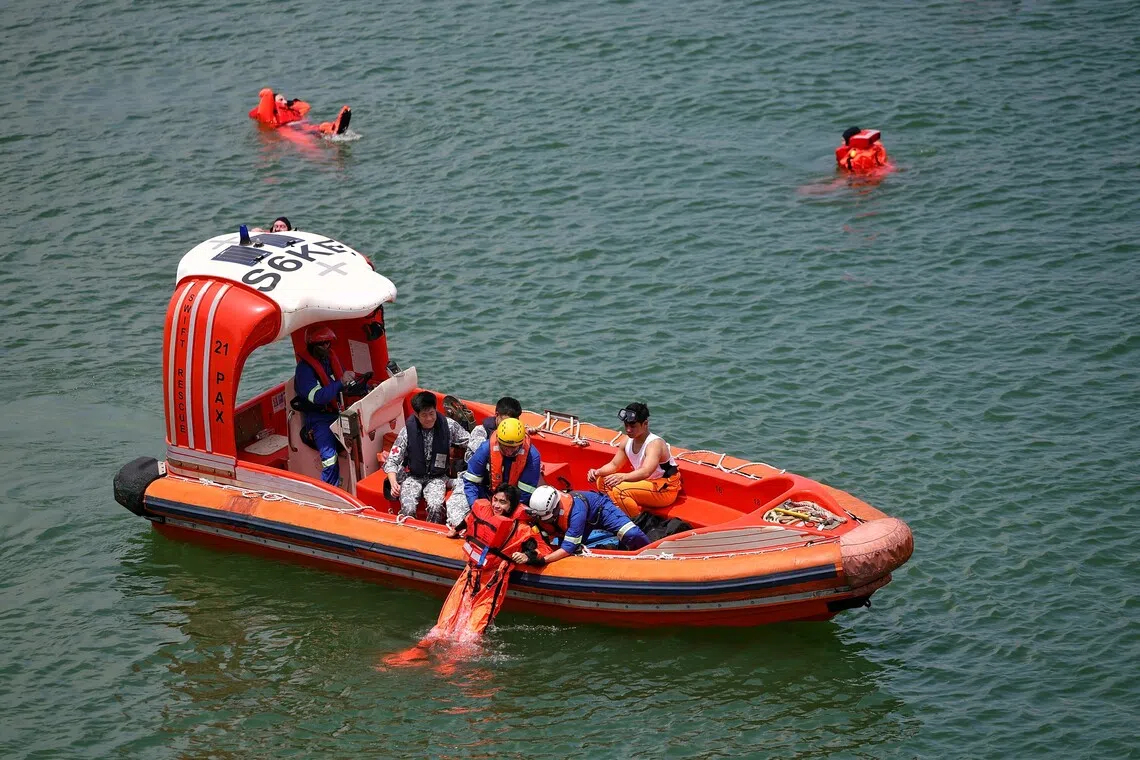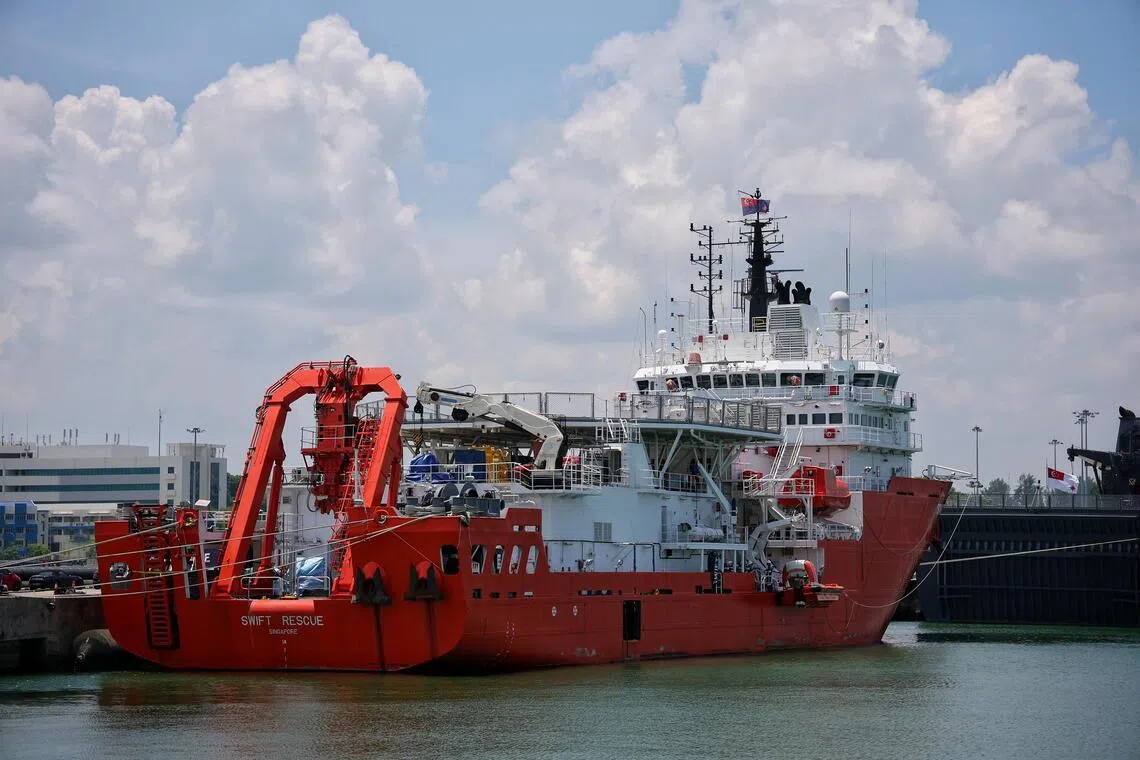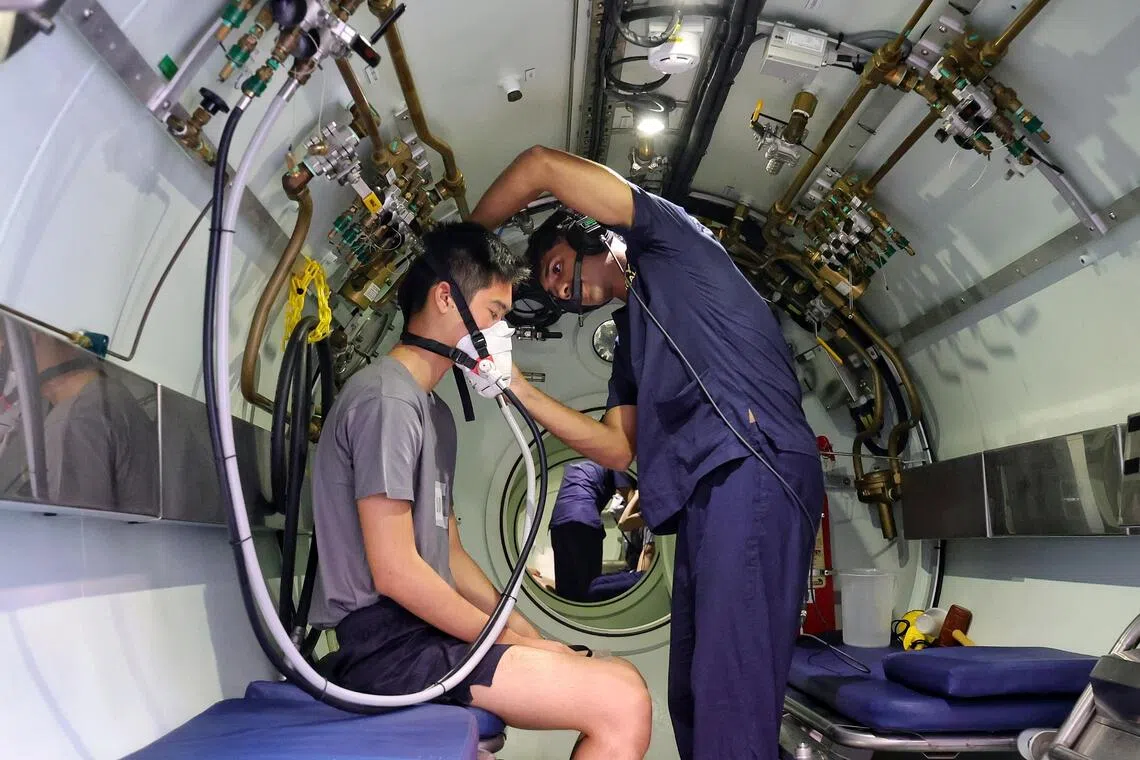Race against time: In-water mass evacuation of submariners staged at Singapore navy exercise
Sign up now: Get ST's newsletters delivered to your inbox

During the drill, about 10 personnel floated for roughly seven minutes before being picked up by a fast rescue craft.
ST PHOTO: KEVIN LIM
Follow topic:
SINGAPORE – When a submarine malfunctions underwater, fire, flooding or rising pressure can quickly render it uninhabitable and force submariners to evacuate.
In such a worst-case scenario, every minute counts. Rescue teams must locate the escaped submariners and bring the crew to safety before medical complications such as decompression sickness set in.
This was the scenario tested during an in-water mass evacuation exercise held in Singapore, the centrepiece of Exercise Pacific Reach 2025 – the largest submarine escape and rescue exercise Singapore has hosted to date.
“The primary concern in a (distressed submarine) scenario would be the well-being of the crew on board,” Colonel Fong Chi Onn, deputy exercise director, said, noting that the environment on board may become challenging as it deteriorates due to the release of poisonous gases, among other dangers.
“All actions that we collectively take in a distressed submarine situation is very much a race against time.”
Exercise Pacific Reach, being held from Sept 15 to 29 at Changi Naval Base, brings together about 600 navy personnel from 17 countries, including Australia, China, India, Malaysia, Turkey, the United Arab Emirates and Vietnam. The exercise aims to boost global submarine and rescue knowledge, strengthen interoperability, and build trust among submarine-operating navies.
The 2025 edition is the largest submarine escape and rescue exercise that Singapore has taken part in, measured by the number of participating assets. It is the third time it is hosted by the Republic of Singapore Navy (RSN), after earlier runs in 2000 and 2010. The exercise is held once every three years.
Seven key naval assets are involved this year: three submarines – Singapore’s RSS Invincible, Japan’s JS Kuroshio and South Korea’s ROKS Shin Dol-seok – and four rescue vessels, namely Singapore’s MV Swift Rescue, India’s INS Nistar, Japan’s JS Chiyoda and Malaysia’s MV Mega Bakti.
The mass evacuation exercise simulated the rescue and medical treatment of personnel from a distressed submarine, starting from the moment a submariner surfaces in the sea. Dressed in bright orange MK11 Submarine Escape Immersion Equipment suits, which are fitted with personal flotation devices, the sailors drifted in open water awaiting recovery.

The Republic of Singapore Navy's MV Swift Rescue is seen during Exercise Pacific Reach 2025 at Changi Naval Base on Sept 18.
ST PHOTO: KEVIN LIM
During the drill, about 10 personnel were deployed into the sea to simulate post-submarine escape conditions. They floated for roughly seven minutes before being picked up by a fast rescue craft and taken to the submarine rescue vessel for the exercise, the MV Swift Rescue.
Once aboard, the submariners were transferred to the deck for evaluation, where medical teams assessed injuries ranging from cuts and burns, to decompression illness and cardiovascular collapse. Depending on their condition, the submariners were sent to the sick bay, resuscitation bay, recompression chamber complex or high-dependency unit.
To coordinate the process, crew members used a whiteboard to track in real time the location of each submariner, his injuries, and his movement through the ship’s medical facilities.

Rescued submariners undergoing medical triage during Exercise Pacific Reach 2025 at Changi Naval Base on Sept 18.
ST PHOTO: KEVIN LIM
This end-to-end simulation is a key part of the first phase of Exercise Pacific Reach. Major Dr Ng Peng, medical exercise planner, said this drill allowed medical personnel to exercise the full end-to-end process, rather than individual components.
He added that it also enhanced their own processes and mutual understanding with international counterparts.
This comes alongside medical symposiums and national submarine rescue system conferences, where crew from all over the world come together to discuss best submarine rescue practices and share their research.
MAJ Ng said: “The submarine medicine community is a very small and niche community, so such exercises provide an opportunity and platform for face-to-face exchange of ideas, new developments in this community, as well as a greater understanding of each other’s medical capabilities.”

Underwater medic LCP Arjun Manikkath helping a rescued submariner undergo increased oxygenation in the hyperbaric chamber during Exercise Pacific Reach 2025 on Sept 18.
ST PHOTO: KEVIN LIM
Escaping from the submarine, however, is a last resort, said COL Fong. There is also submarine rescue, where a submarine rescue vehicle will go down into the ocean where the submarine is, latch onto the distressed submarine, and rescue the crew.
During a submarine rescue, Singapore’s Deep Search and Rescue Six (DSAR 6) rescue vessel – housed aboard the MV Swift Rescue – remains ready for deployment when a rescue situation arises.
In scenarios where the environment on board the submarine is liveable, and the crew can remain on board, DSAR 6 will locate the submarine. Upon locating the submarine, the rescue process takes about five hours.
DSAR 6 requires three people to operate it, and can hold up to 17 people.
“This rescue is infinitely more ideal than going through an escape,” COL Fong said.
The second phase of the exercise will test how well participating rescue ships coordinate with submarines in a complex, multi-asset scenario, helping navies develop a shared understanding of rescue procedures.
Such cooperation among regional navies is important in times of submarine rescue, COL Fong said.
“We may have capable systems individually, but sometimes it is also useful to be able to call a friend for help, which greatly increases the chance of rescue,” he said. This involves an understanding of each other’s submarine rescue capabilities and systems, which was done during the exercise.
“All in all, this builds trust and confidence in submarine rescue, and this is important not just to the submariners, but also to the families of the submariners.”
Personnel from India, South Korea, Japan and Australia echoed the importance of honing rescue skills across navies, calling the exercise a “precious opportunity” to align standards and learn from one another.
Captain Vikas Gautam, Officer-in-Charge of the Submarine Rescue Unit East under the Eastern Naval Command, and Commander Amitsubhro Banerji, Commanding Officer of INS Nistar, from the Indian Navy, also introduced India’s newest diving support vessel, the INS Nistar, that was commissioned in July.
“(This exercise) allows us to carry out our capability validation, because when our rescue assets perform at sea with the international assets in the foreign waters, you get to align our standard operating procedures, which we evolve thereafter, as per the international benchmarks,” Capt Gautam said.
“It gives an opportunity to identify times and ways and means of refinement, and also getting feedback from our peers, which is of immense value to us.”
The exercise comes at a time when Asia is seeing a surge in submarine acquisitions. Vietnam has bought six submarines from Russia, while Indonesia is working towards a fleet of 10 by 2029. Asia now accounts for nearly half of the world’s submarines.
Rear-Admiral Joseph Leong, RSN Fleet Commander during the 2010 exercise, said then that as more countries expand their submarine fleets, it is crucial to maintain a strong network for cooperation in multinational submarine rescue operations.
Against this backdrop, COL Fong said Singapore remains committed to strengthening its rescue capabilities. “For as long as the RSN has had submarines, we have been fully committed to all matters pertaining to submarine rescue,” he said.


